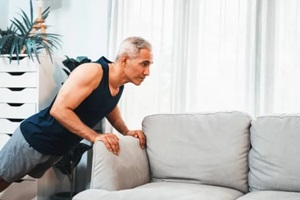 Growing old often comes with a decline in motor skills, but it doesn’t have to mean that you give up on physical activity! In fact, staying in shape can delay or even halt the degeneration of motor abilities and keep your body healthy longer.
Growing old often comes with a decline in motor skills, but it doesn’t have to mean that you give up on physical activity! In fact, staying in shape can delay or even halt the degeneration of motor abilities and keep your body healthy longer.
As an aging athlete, your strategies and approaches will need to be different than those of someone in their 20s, but there’s no reason you can’t enjoy whatever activities suit your fancy.
Whether you’re still at the top of your game or are looking for ways to stay more active, your older years can be a prime opportunity to stay fit as long as you’re smart about it.
Here are the most effective ways to stay in shape as an aging athlete, understanding the changes your body is going through and what you can do to support it.
Accept Changes in Hormones as an Aging Athlete
A person’s hormones will change throughout their lives; in men, for instance, testosterone peaks in the late teens to early twenties and begins a gradual decline from there.
Because testosterone is an important factor in building muscle and maintaining energy, it’s reasonable to conclude that older adults will face more challenges building muscle than their younger peers.
Similarly, women’s estrogen levels decline significantly after menopause, and the body uses estrogen for more than just fertility. For example, those with lower estrogen levels are more likely to experience ACL and other ligament injuries.
Understanding that your hormones will continue to change can moderate your expectations regarding activity. There’s nothing wrong with you; you should simply adjust your goals to fit your body’s capabilities at this stage of life.
Focus on Recovery
For older individuals, recovery is more important than ever. The body takes longer to heal at this stage, and those who skip sufficient recovery are more prone to injuries and problems with mobility.
It is not unreasonable to take multiple days to recover from a workout, especially if it is strenuous. Recovery can still be achieved actively; think of casual biking along a trail or walking through the mall as viable recovery options.
Be Attentive of Injuries That May Be More Prevalent for an Aging Athlete
As mentioned previously, older bodies recover more slowly, including when injured. If an injury occurs during athletic activity, the exercise should be stopped immediately to attend to the problem.
Take lots of rest, and see a doctor to ensure that improper healing does not compromise future movement. Injuries don’t have to spell the end of your physical capabilities as long as they are addressed promptly.
Diversify Movement
Staying in shape as an aging athlete can take many forms, but no matter which activities you find most enjoyable, keep the exercises varied. Repeating the same movement over and over again (such as swinging a tennis racket) can place unnecessary strain on joints that leads to chronic pain and inflammation.
The body does best when it can engage in a wide variety of movements so that all muscles see some action. Your musculature is a connected system. If you only favor one part, the rest could become weak and unable to support movement.
Get Sleep
Sleep is the most important element of an aging athlete’s regimen. During sleep, the body produces the hormones and compounds it needs to rebuild muscle, strengthen the body, and heal microtears and other injuries sustained during activity.
Older athletes should sleep at least 8 hours daily, but listen to your body and rest accordingly. You are more prone to injuries without sleep, and your muscular and endurance progress will likely stall or even backslide.
Hydrate and Be Nutritionally Strategic
 Behind sleep, the next most important elements of a fit lifestyle for older individuals are hydration and nutrition. Sufficient water keeps the body healthy and provides the building blocks for maintaining muscle and removing waste; without it, the body works harder than it needs to.
Behind sleep, the next most important elements of a fit lifestyle for older individuals are hydration and nutrition. Sufficient water keeps the body healthy and provides the building blocks for maintaining muscle and removing waste; without it, the body works harder than it needs to.
Similarly, nutrition is essential, as older adults need more protein than other population segments to maintain their muscle mass. Be smart about your diet, and consider it another part of your exercise regimen rather than something separate.
Learn About Ways an Aging Athlete can Stay Active in Your Area
Staying active can look different for each older adult, and there is no one right way to be an aging athlete. One of the simplest methods is to engage with local opportunities for staying fit, such as clubs and groups.
The team at the Shepherd’s Center of Northern Virginia helps seniors age in place by connecting them with resources in their communities to keep them active and healthy. Avoiding the challenges from aging in place plays a key role in staying healthy.
Contact SCNOVA to learn about the athletic opportunities in your area or to discover a wealth of other resources for those growing older at home.
